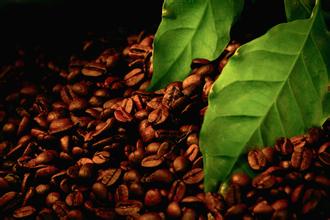Coffee beans have the same characteristics as those of coffee beans.
1. The seed coat of small fruit coffee has been removed, oval or oval in shape, 8-10mm in length, 5-7mm in diameter, 3-4mm in thickness in the middle, raised on the back, flat on the ventral surface, with slightly curved longitudinal groove and paper seed coat marks. Raw products are yellow or dark green; baked products are dark brown with special aroma and slightly bitter taste. Astringent. Coffee flower
2. The seeds of medium fruit coffee are slightly larger, ovoid, 9-11mm long, 7-9mm in diameter, raised abaxially and flat on the ventral side.
3. Coffee seeds with big fruit are oblong, about 15mm long, about 10mm in diameter, smooth.
Microscopic identification: small fruit coffee seed powder characteristics: the raw product is yellowish green and the baked product is brown.
① has many brown lumps of different sizes.
② fiber is slender.
③ stone cells are rectangular and round, with a length of 200 μ m and a diameter of 20-40 μ m.
④ endosperm cell wall is thick, pit can be seen, containing protein grains and fat. Physical and chemical identification to take a little powder of this product, put on the slide, add a little water, heat, wait for the water to dry, add 2 drops of benzene, after drying, there are many yellowish needle crystals along the edge of the slide. Check for caffeine.
In addition, coffee trees can be divided into two main varieties: Arabica (Coffea Arabica) and Robusta (Coffea Robusta/Coffea Canephora). There are also some minor species, such as the Liberian species (Coffea Liberica) and the Alabasta species (Coffea Arabusta), but they are rare on the market.
There are also two processing methods:
1. Dry method: after the fresh fruit is dried or dried, remove the pericarp and seed coat with a sheller and sift out the impurities.
2. Wet method: this method is used for mass production. Peel the fresh fruit with a peeling machine, separate the bean grains from the pericarp, soak the peeled beans in water, wash, dry, and then remove the seed coat to get commercial coffee beans.

Important Notice :
前街咖啡 FrontStreet Coffee has moved to new addredd:
FrontStreet Coffee Address: 315,Donghua East Road,GuangZhou
Tel:020 38364473
- Prev

What should you pay attention to when drinking coffee?
1. Light Roast) vs Deep Baking (Dark Roast) according to the American classification, the roasting of coffee beans can be divided into eight stages from shallow to deep. The taste of coffee mainly depends on the baking degree. Generally, the deeper the roasting degree, the stronger the bitter taste, and the lower the roasting degree, the higher the sour taste. Baking depth mainly depends on the characteristics of raw beans, personal preferences and other factors. two。 Arabica (Arab
- Next

Coffee beans have the same characteristics as those of coffee beans.
1. The seed coat of small fruit coffee has been removed, oval or oval in shape, 8-10mm in length, 5-7mm in diameter, 3-4mm in thickness in the middle, raised on the back, flat on the ventral surface, with slightly curved longitudinal groove and paper seed coat marks. Raw products are yellow or dark green; baked products are dark brown with special aroma and slightly bitter taste. Astringent. Coffee flower 2. Coffee seeds are slightly larger, ovoid, 9-11mm long and 7-7-in diameter.
Related
- Does Rose Summer choose Blue, Green or Red? Detailed explanation of Rose Summer Coffee plots and Classification in Panamanian Jade Manor
- What is the difference between the origin, producing area, processing plant, cooperative and manor of coffee beans?
- How fine does the espresso powder fit? how to grind the espresso?
- Sca coffee roasting degree color card coffee roasting degree 8 roasting color values what do you mean?
- The practice of lattes: how to make lattes at home
- Introduction to Indonesian Fine Coffee beans-- Java Coffee producing area of Indonesian Arabica Coffee
- How much will the flavor of light and medium roasted rose summer be expressed? What baking level is rose summer suitable for?
- Introduction to the characteristics of washing, sun-drying or wet-planing coffee commonly used in Mantenin, Indonesia
- Price characteristics of Arabica Coffee Bean Starbucks introduction to Manning Coffee Bean Taste producing area Variety Manor
- What is the authentic Yega flavor? What are the flavor characteristics of the really excellent Yejasuffi coffee beans?

